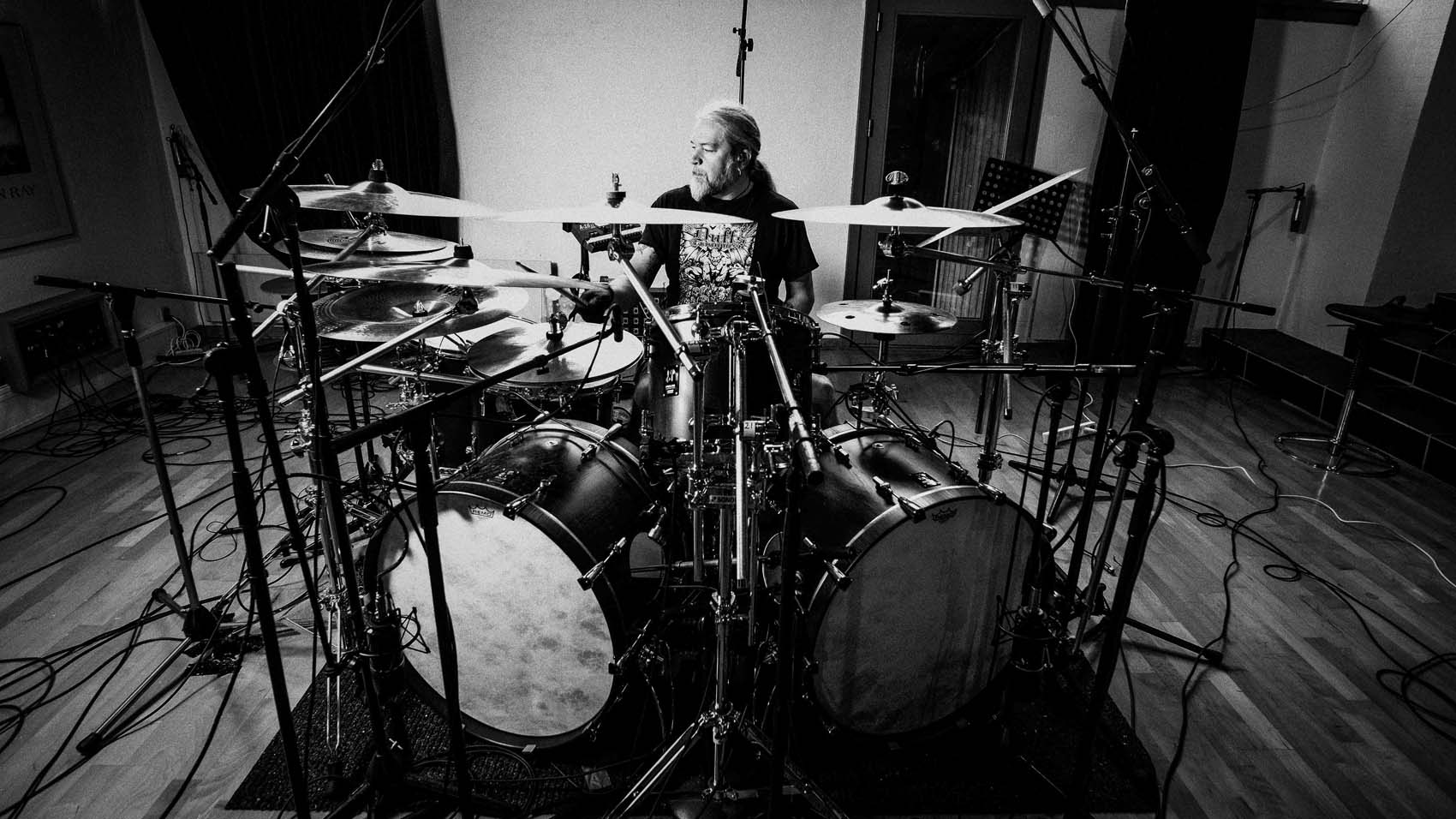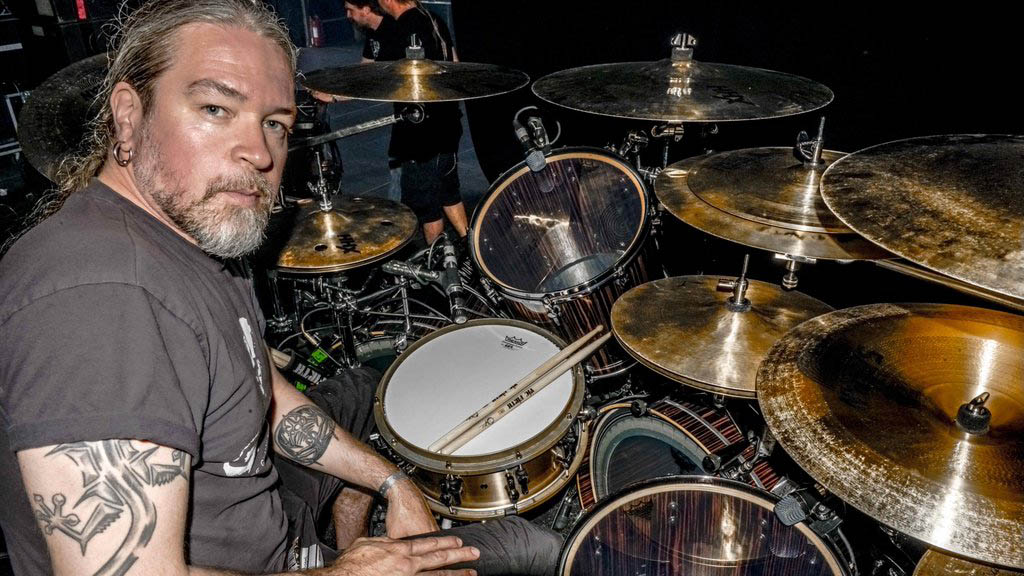Tomas Haake: why Meshuggah returned to live recording and real guitar amps for The Violent Sleep Of Reason
Odd-time master discusses his latest advanced drum mathematics

Introduction: The Violent Sleep Of Reason
In the various adaptations of King Kong over the years, the gargantuan primate has often been described as “the eighth wonder of the world.” It’s an expression that would serve equally as well for Meshuggah - the Swedish progressive metal pioneers have continued to baffle us in ways no-one could have imagined, inspiring countless bands to become more fearless in their manipulation of time.
As a live act, they’ve built a name as one of the deadliest forces known to man: their jarring rhythms more dizzying than any musicians that came before them.
Even when it comes to the gear they use, the quintet were early to embrace original modelling masters Line 6 and, in more recent years, the Fractal Axe-Fx. It’s like they’ve always been one step ahead, if not several.
With this year’s eighth full-length, The Violent Sleep Of Reason, the math-metallers are on fine form indeed, and while never retracing old steps, it harks back to a Meshuggah of old - reminiscent of the bludgeoning grooves heard on early fan-favourite Destroy Erase Improve.
There were no edits… what you hear is what we play
As drummer Tomas Haake explains, it was the down to the recording process first and foremost…
“To some degree, it’s the songwriting, but even more so, I would say it’s the fact that the album was recorded live,” says Haake, chatting with MusicRadar on a sunny afternoon in Soho, London.
“That’s what brought an old-school vibe. I don’t think we’ve done it since [1995’s] Destroy Erase Improve or even [1994’s] None. It’s usually drums first, then everything else on top - but this time it was one guitar, bass, drums and vocals recorded at the same time.
“In the end, it was about choosing takes - obviously you do way more of them, but there were no edits. You don’t get to move hits or fix things… what you hear is what we play.”
Don't Miss
Meshuggah's Mårten Hagström talks Brixton, pyrotechnics and cash

Keeping it real
Fans may also have noticed some of the teaser videos leading up to the album's release featured real guitar amps being recorded in the studio - something quite out of the ordinary for a band that have been so innovative in their quest for tone.
Whether it be Line 6’s Vetta II heads or the trusty Axe-Fx - which, let’s not forget, the metal titans were pivotal in helping establish - Meshuggah have never had any qualms with using digital recreations of analogue sounds.
So what made them want to come back from the future?
“It’s all real amps, man!” grins the drummer.
We wanted to do this old-school in a sense, so we had six amps, six cabs all cranked…
“While I played pretty much the same kit, the biggest change was with the bass and guitar - using amps, cabs and mics instead of recording a clean signal digitally and then re-amping until the end of days when we felt satisfied!
“It’s something we’ve been wanting to do for years and years, for several albums, but for time reasons - and time means money - so financial reasons meant we had to do it that way.
“We never really had enough to properly rehearse material as a whole band before we record them… you end up recording the drums, then fixing the drums, followed by bass and more layers.
“Since forever, it’s always been me recording alone, but this time our bass player Dick [Lövgren] was in there right next to me. I’ve never had a buddy in there - so it was good vibes!
“Over recent years, our guitarist Fredrik [Thordendal] has been collecting gear. He doesn’t drink or use his money for stupid shit like I do, so he actually has some money.
“We wanted to do this old-school in a sense, so we had six amps, six cabs all cranked… for the first time in a long while, it was one loud little room we had there!
“The main amps were the Mesa Boogie Dual Rectifier, I think, and a Marshall JCM800. Plus, there was an Orange/Matamp and another which wasn’t even a tube amp, like some rack thing.”
This one actually has different sounds on each song… It’s not all linear like we’ve done on most albums
Of all guitar amp brands, Orange might seem one of the least synonymous with the scooped metallic crunch Meshuggah are renowned for, but as Haake reveals, choosing different textures to serve each song rather than the album as a whole was paramount in making their eighth opus feel fresh and exciting.
“The beginning part of the last song, Into Decay, has this sound that’s really broken up - that’s the Orange, which we tweaked the hell out of so it would break up to the point where you could barely listen to it. Even though it’s kinda gone as we kick into the song, it’s still there…
“That’s another difference with this album: compared to Obzen, Koloss or most albums we’ve done, this one actually has different sounds on each song. It’s not all linear like we’ve done on most albums, with the same lead, rhythm, drum sounds where it’s all same, same.
“To some extent, I think that gives this album a little more life… there’s more differences. It’s not necessarily even what’s best for the song - it’s just not linear throughout.”

The magic numbers
Even when you listen as far back as their 1991 debut, Contradictions Collapse, Meshuggah have always excelled in rhythmic displacement.
It’s the essence that in many ways has defined them: number-crunching to the point that makes their collective assault feel incredibly alien and not-of-this-world.
But if you ask Tomas Haake, how he and his bandmates keep track of all the divisions and advanced mathematics, the secret is simple… they don’t.
Even if we go into the more complicated signatures, we still feel it as 4/4
“Even if we go into the more complicated signatures, we still feel it as 4/4,” admits Haake.
“What throws people off is that sometimes it’s obvious we’re in 4/4 - you know, the rock beat with the kick on the one and the snare on the two, but there are odd-time cycles. For example, riffs that go on different lengths than just 4, 8 or 16 bars. There might be 13 or 17 notes that repeat and reiterate over the bar line.
“If the snare and hi-hat are playing straight while the feet are following the pattern of the guitar, you still hear that 4/4 - like on our song New Millennium Cyanide Christ. You have that feel because you can hear the backbeat.
“Or a lot of times, the snare might be on the 5th and 11th note of this 13-note riff that repeats, following that cycle’s hits continuously. So then you just have my right hand suggesting where the 4/4 is.
“Sometimes I might use a more washy cymbal, and then it gets a little tricky to follow where the beat is. And the next step would be to learn how the right hand, foot and snare can follow the odd-time riff… that’s when it gets tricky to hear where the 1 is or feel the pulse.”
It makes you wonder: is there any rhythm that can throw the towering human metronome that stands before us today? Bearing in mind his band have built their name on clinically immaculate live performances, evolving into the coldest of killing machines, what does it take to faze a drummer like Tomas Haake?
“It does happen occasionally, but very rarely. Early on maybe, when I’m learning a song and completely lose it - that’s happened a few times.
“But because we don’t really hear it as reiterations, we learn how it sounds almost as if it was a straight-up rock ’n’ roll song. Even if I lose my sticks or whatever, I will still know exactly where I am.
“There’s only one track that stands out - where if I lose where I am, it’s very hard to get back into - and that’s the song Bleed. It’s happened a few times over the years, even live, where you might hear me go silent for a bit. I have to really listen to the riff to get back into it.
“To play the pattern is one thing - there’s a lot of drummers that can do that. It’s more about the complexity with different groupings which get longer and longer throughout the bar. That’s where it gets tricky, and it’s a challenge for us, too, still!”
The Violent Sleep Of Reason is out on 7 October via Nuclear Blast. Meshuggah tour the UK in January 2017:
12 January - Bristol (UK) O2 Academy
13 January - Birmingham (UK) O2 Institute
14 January - Nottingham (UK) Rock City
15 January - Glasgow (UK) O2 ABC
17 January - Belfast (UK) Limelight
18 January - Dublin (IRL) Vicar Street
19 January - Manchester (UK) O2 Ritz
20 January - London (UK) O2 Forum
Don't Miss
Meshuggah's Mårten Hagström talks Brixton, pyrotechnics and cash
Amit has been writing for titles like Total Guitar, MusicRadar and Guitar World for over a decade and counts Richie Kotzen, Guthrie Govan and Jeff Beck among his primary influences. He's interviewed everyone from Ozzy Osbourne and Lemmy to Slash and Jimmy Page, and once even traded solos with a member of Slayer on a track released internationally. As a session guitarist, he's played alongside members of Judas Priest and Uriah Heep in London ensemble Metalworks, as well as handling lead guitars for legends like Glen Matlock (Sex Pistols, The Faces) and Stu Hamm (Steve Vai, Joe Satriani, G3).
